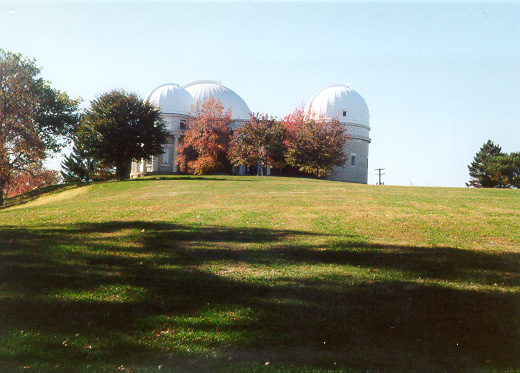2012 August 17
Public comments submitted, 2012 August 17, by Glenn A. Walsh for the National
Research Council's independent study of NASA's Strategic Direction:
1. Name and identity
Glenn Walsh
Former
Astronomical Observatory Coordinator and Planetarium Lecturer, Original
Buhl Planetarium and Institute of Popular Science, Pittsburgh
I
explained astronomy and the space sciences to the general public and to
school groups, at Pittsburgh's original Buhl Planetarium.
2. Contact information
E-mail:
gaw@planetarium.cc
Telephone: 412-561-7876
3. NASA's Vision, Mission and Strategic Direction.
QUESTION:
What is your understanding and opinion of NASA's current vision,
mission and strategic direction? If you think NASA's vision, mission and
strategic direction should be different from the above, please state what
they should be and why.
ANSWER:
As a publicly-funded agency, I
regret that NASA's vision, mission, and strategic direction often
fluctuates with the desires of the Federal Administration, Congress, and
the American People. Yet, in a democracy it is certainly
understandable, and I would even say desirable, that the people have
proper oversight and direction over any publicly-funded agency, and
certainly an agency as important as NASA.
I would suggest that it
might improve the effectiveness of NASA if the Federal Administration
and Congress would agree on a ten-year plan for NASA. Such a plan would
satisfy the very legitimate need for proper public oversight and
direction of NASA, while allowing NASA to better plan its projects and
activities.
4. Budget
QUESTION: In your opinion, should NASA's
annual budget (currently about $18 billion) be substantially increased,
be substantially decreased, or remain at about the current level – and
why? [In responding to this question, assume that an increase in NASA's
budget would require reduction(s) elsewhere in the federal budget and,
conversely, that a decrease in NASA's budget would enable increased
funding elsewhere in the federal budget.]
ANSWER:
Along with
my suggestion in item number 3, the NASA budget should be agreed-to as
part of a ten-year plan. Hence, NASA would be assured of how much money
they have to plan their projects and activities.
With the shift
to the promotion of a more robust commercial space program, which I
completely agree with and strongly support, NASA's resources should
shift to projects that would not likely be supported by a commercial
space program. Primarily, this would be planetary space research and
public education.
NASA should now concentrate on basic scientific
research, which would provide the scientific knowledge needed for
future expansion into the solar system. Most applied research should be
left to the commercial space entities.
Hence, future NASA budgets
(and the ten-year plan budget that I propose and support) should be
based on NASA's needs for such a basic research thrust, as well as on
their needs to effectively educate the public on the importance of our
future in outer space.
5. Human Component of Space Exploration.
QUESTION:
In your opinion, what is the relative value of a space exploration
program (to low-Earth orbit and beyond) that includes humans as compared
to a space exploration program that is conducted exclusively with
robotic, uncrewed spacecraft and rovers? That is, to what extent does a
human presence add value to a space exploration program, and is it worth
the cost and risk?
ANSWER:
Human exploration of outer space
is extremely important to the future of our civilization. This is the
reason I strongly support a robust, manned commercial space program. A
government-only manned space program will not have the resources to move
people into outer space as rapidly as I believe needs to happen. I
wrote a short commentary on these views for the 2005 June issue of The
Planetarian, the quarterly journal of the International Planetarium
Society:
>>>
http://buhlplanetarium2.tripod.com/IPS/Planetarian2.htm
First,
NASA should use its resources to maintain major space infrastructure
investments already made by the United States of America. This would
include the International Space Station and, possibly, the Hubble Space
Telescope. The resources needed to access and use the International
Space Station must be expended, to be sure these infrastructure
investments will not be wasted.
NASA should consider
contracting-out these duties to private vendors. A private vendor may be
able to bring down the price to a more reasonable level, including
another maintenance visit to Hubble.
Finally, NASA needs to spend
more resources on determining how men and women can safely work and
travel in space. Determining the facilities and strategies needed to
ensure that the human body can safely work and travel in the space
environment is extremely important for the future of mankind in space.
For
instance, until "Star Trek"-type spaceship gravity can be invented, it
may be wise to have people living on large space stations orbiting the
Moon or Mars, which rotate to provide the needed gravity. These people
would commute to the planet's surface for exploration, mining, and other
scientific or commercial purposes and commute back to the space station
at the end of their work day.
In addition to gravity, protection
from cosmic rays is another major challenge to human use of space that
NASA should spend resources to work on.
6. NASA Communications
QUESTION:
Do you feel that NASA is very good, moderately good or not very good at
communicating its vision, mission and strategic direction to its
stakeholders, including the public? Why? How do you obtain information
about NASA (TV news, websites, Twitter or other social media, etc.). If
you think NASA's communication strategy needs improvement, what
specifically do you recommend? Why?
ANSWER:
I have been
receiving news releases and other information from NASA since the 1970s,
when I was General Manager of a very small, educational radio station
near White Sulphur Springs, West Virginia:
>>>
http://johnbrashear.tripod.com/wlcr.html
In
addition to news releases, NASA sent us phonograph records which
included the weekly radio program, "The Space Story," which was hosted
by Willard Scott.
Additionally, they sent us a news release
informing us that they would provide a toll-free telephone number for
updated news reports regarding the Viking missions to Mars in 1976. So,
we were able to inexpensively broadcast these NASA news reports to the
summer campers of Camp Shaw-Mi-Del-Eca, the owner of this educational
radio station.
I received similar support from NASA in the 1980s
and early 1990s, when I was Astronomical Observatory Coordinator and a
Planetarium Lecturer at Pittsburgh's original Buhl Planetarium and
Institute of Popular Science.
During the latter half of the
1990s, when I served as a Life Trustee on the Board of Trustees of the
Andrew Carnegie Free Library and Music Hall in Carnegie, Pennsylvania, I
was able to obtain for the Library a free subscription to the monthly
"NASA Tech Briefs" magazine.
So, I have been very pleased with NASA's commitment, over the years, to public education.
Today,
I receive NASA news releases, including NASA Science News reports,
through my e-mail subscriptions. I also visit NASA web sites frequently.
While
I understand the limited resources available, I urge NASA to continue
the public outreach I have experienced over the last 40 years. The
future of our civilization is in outer space, and it is essential that
the public understands that this is where, potentially, thousands of new
jobs, both scientific and commercial, will be created.
7. International Collaboration
QUESTION:
Should the United States conduct future human space exploration efforts
on its own, like the Apollo program, or should the United States
conduct such efforts as collaborative international efforts, like the
International Space Station? If you recommend the latter approach,
should the United States insist on taking the lead role? Why?
ANSWER:
International
collaboration in space and scientific exploration and research is
always preferable, where possible. The International Space Station is an
excellent example of how well such collaborations can work.
There
may be some areas of space and science exploration and research where
the United States of America should go it alone. National security would
probably be the primary example of this. However, such national
security space and science exploration and research should be conducted
through DARPA, while NASA continues such research in non-national
security areas.
At this point in time, I do think that the United
States of America should take the lead in most international
collaborations. As future use in outer space will result in,
potentially, thousands of new jobs. I, certainly, would like to see a
lot of those jobs going to Americans.
Further, as commercial and
real estate developments begin to proliferate in outer space, I strongly
believe that most of these developments should promulgate American
values of democracy and free enterprise. Without American leadership,
other political and economic systems could become predominant in outer
space, such as China's system of authoritarianism and "state
capitalism." This would be a tragedy for both the United States of
America and for the future of mankind in outer space.
8. Commercial Space Ventures
QUESTION:
Should NASA and the federal government continue current efforts to
encourage the development of a commercial space industry as is, or
should it either curtail or expand these efforts? What specific actions
would you recommend? Why?
ANSWER:
NASA and the Federal
Government should absolutely expand efforts to encourage the development
of a major commercial space industry. Outer space is our future, and
the United States of America needs a major commercial space industry to
successfully bring the benefits of space exploration and research to the
American people.
Government space programs will never have the
resources to truly exploit the opportunities of outer space. As with all
other areas of society, it is important that government make the infrastructure and other investments necessary to allow commercial
enterprises to blossom. Such a collaboration between government and
industry will make a very promising future for mankind in space, as well
as for the United States of America.
Source: Friends of the Zeiss
MORE INFORMATION ON NATIONAL RESEARCH COUNCIL INDEPENDENT STUDY OF THE NASA STRATEGIC DIRECTION:
>>>
http://sites.nationalacademies.org/DEPS/ASEB/DEPS_067029?ssSourceSiteId=SSB
ALSO SEE FIRST BLOG POSTING:
Your Chance to Tell NASA What It Should Do
>>>
http://spacewatchtower.blogspot.com/2012/08/your-chance-to-tell-nasa-what-it-should.html
gaw
Glenn A. Walsh, Project Director,
Friends of the Zeiss <
http://friendsofthezeiss.org >
Electronic Mail - <
gawalsh@planetarium.cc >
SPACE & SCIENCE NEWS, ASTRONOMICAL CALENDAR:
<
http://buhlplanetarium.tripod.com/#news >
Twitter: <
http://twitter.com/spacewatchtower >
Facebook: <
http://www.facebook.com/pages/SpaceWatchtower/238017839577841?sk=wall >
Blog: <
http://spacewatchtower.blogspot.com/ >
Author of History Web Sites on the Internet --
* Buhl Planetarium, Pittsburgh:
<
http://www.planetarium.cc >
* Adler Planetarium, Chicago:
<
http://adlerplanetarium.tripod.com >
* Astronomer, Educator, Optician John A. Brashear:
<
http://johnbrashear.tripod.com >
* Andrew Carnegie & Carnegie Libraries:
<
http://www.andrewcarnegie.cc >
* Civil War Museum of Andrew Carnegie Free Library:
<
http://garespypost.tripod.com >
*
Duquesne Incline cable-car railway, Pittsburgh:
<
http://inclinedplane.tripod.com >
* Public Transit:
<
http://andrewcarnegie2.tripod.com/transit >















